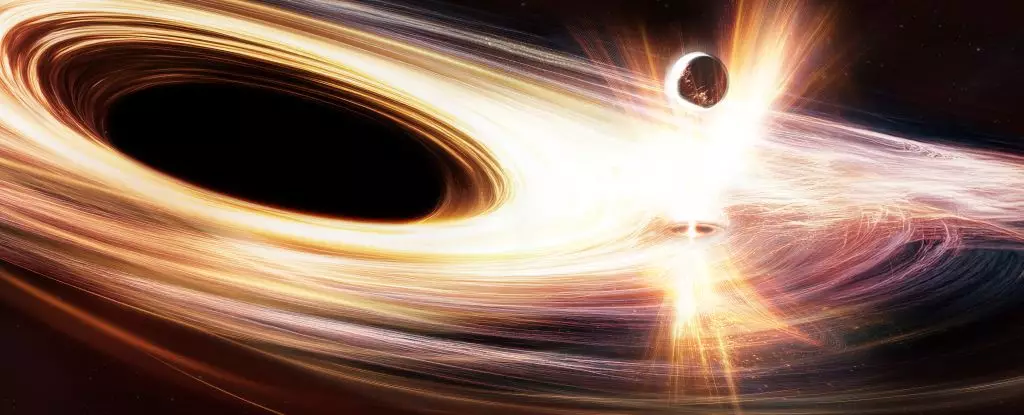A supermassive black hole located 300 million light-years from Earth, named Ansky, has recently captivated the attention of astrophysicists around the globe. Nestled at the heart of the galaxy SDSS1335+0728, Ansky has displayed an unexpected resurgence in activity since 2019, flaring with startling brightness and emitting powerful bursts of X-rays. While researchers have long observed black holes transitioning between states of activity and dormancy, Ansky’s behavior is perplexingly anomalous and challenges long-held astrophysical models. Unlike typical black holes, Ansky’s eruptions are both remarkably vibrant and prolonged, creating a conundrum that eludes traditional explanations.
Transformative Eruptions That Break the Mold
Astrophysicist Joheen Chakraborty from MIT has aptly highlighted the peculiar attributes of Ansky’s eruptions, noting that they are ten times longer and shine ten times brighter than typical quasi-periodic eruptions observed in other black holes. Each event releases an astounding amount of energy—equivalent to a hundred times more than previously recorded eruptions. Notably, these explosions exhibit a cadence never before witnessed, with intervals spanning approximately 4.5 days. Such extraordinary characteristics compel researchers to rethink entrenched beliefs about the processes fueling these cosmic phenomena. Ansky’s unique dynamism pushes the limits of existing astrophysical models and invites new interpretations of black hole behavior.
The Oversimplified Notion of Black Holes
The traditional view of black holes as cosmic vacuum cleaners misses the nuances of their existence. While they are indeed powerful gravitational forces, the reality is far more intricate. Supermassive black holes like Ansky can oscillate between furious activity and measured quiescence—periods when they are minimally interacting with their cosmic surroundings. For instance, while our own Milky Way boasts a relatively dormant black hole at its core, Ansky’s awakening challenges our understanding of how these entities evolve and interact with their host galaxies.
Crucially, the cycles of activity and dormancy appear to play significant roles in shaping the galaxies that harbor these colossal forces. As black holes accrete mass, they influence star formation, chemical evolution, and the structural formation of galaxies. The very act of ‘feeding’ can create extraordinary jets of energy and luminosity, identifiable by advanced observational technologies.
Ansky’s Awakening: A Historic Observation
In 2019, Ansky made headlines as the first supermassive black hole to be observed transitioning from a quiet state to an active phase in real-time. As Lorena Hernández-García, an astronomer involved in the research, states, this development marks a landmark moment in astrophysics. The onset of its quasi-periodic eruptions represents not just a scientific breakthrough but an unveiling of a continuum of black hole behavior that was previously enigmatic. With scientists continuously monitoring this extraordinary entity, there’s hope that future observations may unravel the mysteries surrounding its explosive activity.
This newfound knowledge could also shed light on other black holes under similar scrutiny, enhancing our understanding of their dynamics and the factors precipitating their eruptions. While some theories suggest that the cause of these bursts stems from smaller celestial objects being captured by the gravitational pull of supermassive black holes, Ansky’s behavior raises significant questions about the veracity of this assumption.
Implications Beyond Observation
Ansky’s eruptions do not merely contribute to our knowledge of black holes; they also pose potential implications for gravitational wave detection. As pointed out by Erwan Quintin, an astronomer from the European Space Agency, the repetitive nature of these bursts might correlate with gravitational waves, which are anticipated to be captured by future missions like LISA (Laser Interferometer Space Antenna). This indicates that studying Ansky holds the promise of bridging multiple facets of astrophysical research and could fundamentally reshape our understanding of cosmic events.
In this sense, Ansky stands at the cusp of revolutionizing astrophysics, potentially leading to breakthrough theories about the relationships between massive black holes, the formation of galaxies, and the intricate phenomena governed by gravitational dynamics. The excitement surrounding Ansky’s unique attributes is amplified by the acknowledgment that many of the fundamental assumptions in astrophysics may need revision.
In an age where the study of black holes remains at the forefront of cosmic exploration, the story of Ansky exemplifies the confluence of curiosity and discovery—an eternal pursuit to unveil the deeper secrets of our universe. Each observation reaffirms that in the realm of astrophysics, there is always more to learn, and Ansky is poised to redefine our understanding of the cosmos.


Leave a Reply